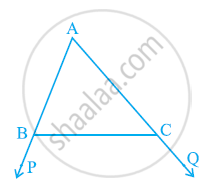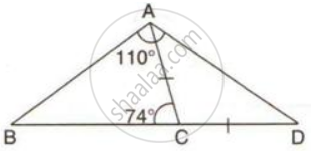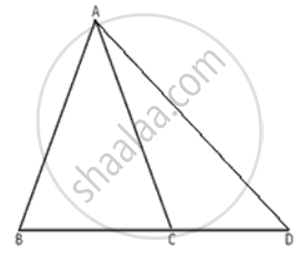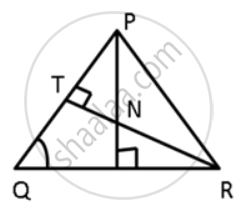Advertisements
Advertisements
Question
Name the greatest and the smallest sides in the following triangles:
ΔXYZ, ∠X = 76°, ∠Y = 84°.
Solution
In ΔXYZ,
∠X + ∠Y + ∠Z = 180°
76° + 84° + ∠Z = 180°
160° + ∠Z = 180°
∠Z = 180° - 160°
∠Z = 20°
Hence, ∠X = 76°, ∠Y = 84°, ∠Z = 20°
In the given ΔXYZ the greatest angle is ∠Y and
the opposites side to the ∠Y is XZ.
Hence, the greatest side is XZ.
The smallest angle in the ΔXYZ is ∠Z and the
opposite side to the ∠Z is XY.
Hence, the smallest side is XY.
APPEARS IN
RELATED QUESTIONS
In the given figure sides AB and AC of ΔABC are extended to points P and Q respectively. Also, ∠PBC < ∠QCB. Show that AC > AB.

In the given figure, PR > PQ and PS bisects ∠QPR. Prove that ∠PSR >∠PSQ.

ABC is a triangle. Locate a point in the interior of ΔABC which is equidistant from all the vertices of ΔABC.
If two sides of a triangle are 8 cm and 13 cm, then the length of the third side is between a cm and b cm. Find the values of a and b such that a is less than b.
In the following figure ; AC = CD; ∠BAD = 110o and ∠ACB = 74o.
Prove that: BC > CD.
In the following figure, write BC, AC, and CD in ascending order of their lengths.
"Issues of caste discrimination began to be written about in many printed tracts and essays in India in the late nineteenth century." Support the statement with two suitable examples.
Name the smallest angle in each of these triangles:
In ΔABC, AB = 6.2cm, BC = 5.6cm and AC = 4.2cm
ΔABC is isosceles with AB = AC. If BC is extended to D, then prove that AD > AB.
In the given figure, ∠QPR = 50° and ∠PQR = 60°. Show that: SN < SR
